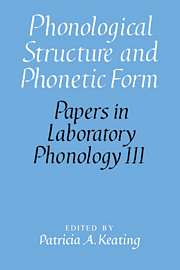Book contents
- Frontmatter
- Contents
- List of contributors
- Acknowledgments
- 1 Introduction
- I Intonation
- II Syllables
- 8 Articulatory phonetic clues to syllable affiliation: gestural characteristics of bilabial stops
- 9 The phonology and phonetics of extrasyllabicity in French
- 10 Phonetic correlates of syllable affiliation
- 11 Syllable structure and word structure: a study of triconsonantal clusters in English
- III Feature Theory
- IV Phonetic Output
- Index of subjects
- Index of names
10 - Phonetic correlates of syllable affiliation
Published online by Cambridge University Press: 26 February 2010
- Frontmatter
- Contents
- List of contributors
- Acknowledgments
- 1 Introduction
- I Intonation
- II Syllables
- 8 Articulatory phonetic clues to syllable affiliation: gestural characteristics of bilabial stops
- 9 The phonology and phonetics of extrasyllabicity in French
- 10 Phonetic correlates of syllable affiliation
- 11 Syllable structure and word structure: a study of triconsonantal clusters in English
- III Feature Theory
- IV Phonetic Output
- Index of subjects
- Index of names
Summary
In this commentary I intend to focus on the issue of deciding whether a consonant belongs to a particular syllable or not. This issue is dealt with in detail in Turk's paper, and is touched on more briefly by Rialland where she considers acoustic arguments for extrasyllabicity.
Turk uses x-ray microbeam data to demonstrate that medial labial stops in an English word like leper have closing and opening gestures more similar to those of phonologically unambiguously syllable-final labials (e.g. captor) than to those of syllable-initial labials (e.g. repair). The discriminant analysis of the articulatory data points pretty clearly to the conclusion that a medial stop following a stressed syllable belongs in that syllable.
Rialland, in her section 9.2.3.1.1, argues briefly from acoustic data for the conclusion that the initial velar in a French sequence such as /kn∍t/ is extrasyllabic. Specifically, the burst frequency of the velar does not vary across a range of vowel environments in the way that it would if the velar immediately preceded the vowel or an intervening liquid. There are good phonological arguments for an extrasyllabic treatment, which Rialland also presents, and the acoustic data appears to provide useful confirmation of the phonological analysis.
However, a number of interesting questions are raised by work of these kinds, such as
(a) Do other similar sounds pattern in the same way as the stops examined?
(b) Which of the many phonetic dimensions, both articulatory and acoustic, are of relevance for the matter of syllable affiliation?
(c) If different phonetic dimensions point to conflicting syllable divisions, how could the conflict be resolved?
[…]
- Type
- Chapter
- Information
- Phonological Structure and Phonetic Form , pp. 160 - 167Publisher: Cambridge University PressPrint publication year: 1994
- 1
- Cited by

